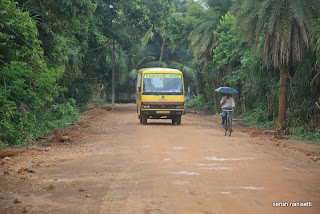“It began as a gentle breeze on the morning of October 12.
By afternoon anything that could fly was flying. Then it became very dark and
the rain came in sheets and the sound of wind changed to a shrill sharp
whistle. Then silence. Utter quiet. At 8.30 p.m. there was a distant roar with
whooo sound, like a pack of wolves, it was coming from all sides and it grew
fearsomely louder. I remembered 1999 and ran inside and bolted the door and the
pet dog wouldn’t leave my side,” says Venkatesh, a fisherman, who saw Cyclone
Phailin strike Gopalpur on Sea just 600 metres from the coastline.
“It was like a mirror. A sheet of water and me and my
friends could not take a step in the rain without the fear of being blown
away,” says Ritesh, an engineering student, who clambered to the terrace of
hostel building of National Institute of Science and Technology.
Repairing, make it reassembling, their thatched house, the
fisherfolk in Kotta Bauxpalli how they were forced to leave with whatever they
could carry on their person on the day of the cyclone and shifted to a school
on the hill. “When we came back, there was nothing left, we could salvage some
bamboo sticks and brought some new coconut leaves to put the roof back on,”
says Korlamma, a housewife, as the family works on the thatched house.
They said Cyclone Phailin packed the power of 100 H-bombs.
Oddly enough, Gopalpur and its neighbouring villages now resemble a warzone
with nothing vertical except concrete constructions. Some cellphone towers have
appear as if they are draped around the building they were standing. Centuries
old banyan and peepul trees have been plucked out of ground like rice plants.
Transmission towers and coconut trees have been snapped into two like
matchsticks.
It will take some years for the villagers to get back on to their feet.
























No comments:
Post a Comment